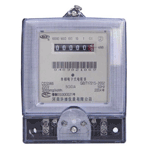 |
|
DDS566-C01
|
 |
|
DDS566-C02
|
 |
|
DDS566-C03
|
|
| | |
 |
Single phase
electronic watt-hour meter (cyclometer) |
| |
| |
DDS566
single phase electronic watt-hour meter adopts
LSI, latest micro-electronic technology &
SMT technique, with advanced processing and
simple structure and modern special IC chip to
raise the meter’s dynamic working scope.
Long-life and high-reliability components are
adopted to ensure the long-term operation
stability of the energy meter. It used for
measuring rated frequency 50Hz/60Hz active
energy with high accuracy and little power
loss. DDS566 series Single Phase electronic
watt-hour meter has the features of
anti-tamper, high allowable overload &
light weight etc.
DDS566
series Single Phase electronic watt-hour meter
conforms to the standards as follow: GB/T
17215-2002 (IEC61036-2000)
|
| |
| Technical parameters
|
class:
1.0 or 2.0
rated
voltage: 100V, 110V, 120V, 220V,
230V, 240V (three wire 100/220V)
rated
current: 1.5(6)A, 5(30)A, 10(40)A,
15(60)A, 20(80)A, 10(100)A
power
loss: 0.5W
operating temperature:
-30℃-+60℃
|
|
Main features
|
Excellent against
tamper and fraud function
Anti high magnet
cyclometer, Good electromagnetic compatibility
(EMC)
High reliability,
high precision under low load.
|
| |
| Special tamper and fraud
proof function (Customer specified) |
The meter can continue to
register active energy accurately under
conditions a, b, c, d & e
a) On reversal (Interchange) of input
(line) and output (load) terminals.
b) On reversal (Interchange)
of phase and neutral at the mains or incoming
supply side of meter terminals
c) Using earth in place of
neutral (i.e. when load is not terminated back
to the meter and instead current is drawn
partially or fully through a local earth)
irrespective of the phase and neutral
connections to the meter.
d) The meter shall be immune
to tampering through application of external
magnetic field (A.C Electro-Magnet or D.C
magnet)
e) When Neutral is absent
from both side (Supply side as well as load
side) and load is operated through earth.
f) Any combination of the
conditions described above under (a), (b), (c),
(d) & (e). The accuracy of the meter should
not differ with main accuracy
|
|
|
| | |